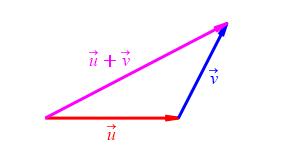5. Vectors
b. Vector Addition
3. Properties
We here list the algebraic properties of vector addition and its relation to magnitude.
In the following, \(\vec u\), \(\vec v\), and \(\vec w\) are vectors. Also, \(\vec 0=\langle0,0\rangle\) is called the Zero Vector which is the vector whose components are both zero , while \(-\vec v=\langle-v_1,-v_2\rangle\)is called the Negative of \(\vec v\) which is the vector whose components are the negatives of those for \(\vec v\).
First, there are \(7\) properties involving just vector addition.
Let \(\vec u\), \(\vec v\), and \(\vec w\) be arbitrary vectors. Then,
- Addition is Commutative: \(\vec u+\vec v=\vec v+\vec u\)
\[\begin{aligned} \vec u+\vec v &=\left\langle u_1,u_2\right\rangle+\left\langle v_1,v_2\right\rangle =\left\langle u_1+v_1,u_2+v_2\right\rangle \\ &=\left\langle v_1+u_1,v_2+u_2\right\rangle =\left\langle v_1,v_2\right\rangle+\left\langle u_1,u_2\right\rangle \\ &=\vec v+\vec u \end{aligned}\] A geometrical proof was also given on the previous page.
- Addition is Associative: \((\vec u+\vec v)+\vec w=\vec u+(\vec v+\vec w)\)
\[\begin{aligned} (\vec u+\vec v)+\vec w &=\big(\left\langle u_1,u_2\right\rangle+\left\langle v_1,v_2\right\rangle\big) +\left\langle w_1,w_2\right\rangle \\ &=\left\langle u_1+v_1,u_2+v_2\right\rangle+\left\langle w_1,w_2\right\rangle \\ &=\left\langle u_1+v_1+w_1,u_2+v_2+w_2\right\rangle \\ &=\left\langle u_1,u_2\right\rangle+\left\langle v_1+w_1,v_2+w_2\right\rangle \\ &=\left\langle u_1,u_2\right\rangle +\big(\left\langle v_1,v_2\right\rangle+\left\langle w_1,w_2\right\rangle\big) \\ &=\vec u+(\vec v+\vec w) \end{aligned}\]
- \(\displaystyle \vec 0\) is the Zero or Additive Identity: \(\displaystyle \vec v+\vec 0=\vec v\)
\[\begin{aligned} \vec v+\vec 0 &=\left\langle v_1,v_2\right\rangle+\left\langle0,0\right\rangle \\ &=\left\langle v_1+0,v_2+0\right\rangle \\ &=\left\langle v_1,v_2\right\rangle \\ &=\vec v \end{aligned}\]
- \(-\vec v\) is the Negative or Additive Inverse of \(\vec v\): \(\displaystyle \vec v+(-\vec v)=\vec 0\)
\[\begin{aligned} \vec v+(-\vec v) &=\left\langle v_1,v_2\right\rangle+\left\langle-v_1,-v_2\right\rangle \\ &=\left\langle v_1-v_1,v_2-v_2\right\rangle \\ &=\left\langle0,0\right\rangle=\vec 0 \end{aligned}\]
-
The Zero Vector, \(\vec 0\), is Unique:
If \(\vec z\) is a vector which satisfies \(\vec v+\vec z=\vec v\), then \(\vec z=\vec 0\).
If \(\vec z=\left\langle z_1,z_2\right\rangle\) and \(\vec v=\left\langle v_1,v_2\right\rangle\), then: \[ \vec v+\vec z=\left\langle v_1+z_1,v_2+z_2\right\rangle \] So the equation \(\vec v+\vec z=\vec v\) says: \[ v_1+z_1=v_1 \qquad \text{and} \qquad v_2+z_2=v_2 \] So \(z_1=0\) and \(z_2=0\), or \(\vec z=\vec 0\).
-
The Negative, \(-\vec v\), is Unique:
Given a vector \(\vec v\), if a vector \(\vec w\) satisfies \(\vec v+\vec w=\vec 0\), then \(\vec w=-\vec v\).
If \(\vec w=\left\langle w_1,w_2\right\rangle\) and \(\vec v=\left\langle v_1,v_2\right\rangle\), then: \[ \vec v+\vec w=\left\langle v_1+w_1,v_2+w_2\right\rangle \] So the equation \(\vec v+\vec w=\vec 0\) says: \[ v_1+w_1=0 \qquad \text{and} \qquad v_2+w_2=0 \] So \(w_1=-v_1\) and \(w_2=-v_2\), or \(\vec w=-\vec v\).
-
Additive Cancellation:
If \(\vec u+\vec v=\vec w+\vec v\), then \(\vec u=\vec w\).
If \(\vec u=\left\langle u_1,u_2\right\rangle\), \(\vec v=\left\langle v_1,v_2\right\rangle\) and \(\vec w=\left\langle w_1,w_2\right\rangle\), then: \[ \vec u+\vec v=\left\langle u_1+v_1,u_2+v_2\right\rangle \] and \[ \vec w+\vec v=\left\langle w_1+v_1,w_2+v_2\right\rangle \] So the equation \(\vec u+\vec v=\vec w+\vec v\) says: \[ u_1+v_1=w_1+v_1 \qquad \text{and} \qquad u_2+v_2=w_2+v_2 \] So \(u_1=w_1\) and \(u_2=w_2\), or \(\vec u=\vec w\).
Further, vector addition is related to magnitude by the triangle inequality which basically says that each side of a triangle is shorter than the sum of the other two sides and longer than the difference between the other two sides:
Let \(\vec u\) and \(\vec v\) be arbitrary vectors. Then,
- Triangle Inequality: \(\left|\rule{0pt}{9pt}\,|\vec u|-|\vec v|\,\right| \le |\vec u+\vec v| \le |\vec u|+|\vec v|\)
\(\quad\Longleftarrow\quad\Longleftarrow\quad\) Read this. It's easy and informative!

Optional
Vector Addition Properties 5, 6 and 7 were proved above by writing out
the components of the equations. They can also be proved using only
Vector Addition Properties 1-4, without writing out any components.
These proofs will be assigned in the
exercises.
Heading
Placeholder text: Lorem ipsum Lorem ipsum Lorem ipsum Lorem ipsum Lorem ipsum Lorem ipsum Lorem ipsum Lorem ipsum Lorem ipsum Lorem ipsum Lorem ipsum Lorem ipsum Lorem ipsum Lorem ipsum Lorem ipsum Lorem ipsum Lorem ipsum Lorem ipsum Lorem ipsum Lorem ipsum Lorem ipsum Lorem ipsum Lorem ipsum Lorem ipsum Lorem ipsum